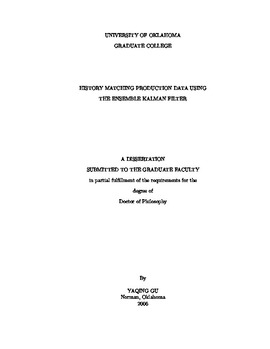| dc.contributor.advisor | Oliver, Dean, | en_US |
| dc.contributor.author | Gu, Yaqing. | en_US |
| dc.date.accessioned | 2013-08-16T12:20:32Z | |
| dc.date.available | 2013-08-16T12:20:32Z | |
| dc.date.issued | 2006 | en_US |
| dc.identifier.uri | https://hdl.handle.net/11244/1143 | |
| dc.description.abstract | In this dissertation, the ensemble Kalman filter (EnKF) is refined for applications to the problem of history matching. This method assimilates data sequentially whenever data are acquired. It is a Monte Carlo approach, in which an ensemble of models is used. The correlations between model variables and theoretical data are computed directly from the ensemble. Multiple history-matched models will be obtained after the initial ensemble is conditioned to all production data. The final models can be used to assess the uncertainty in future reservoir performance. The computational cost for generating the multiple history-matched models is approximately the simulation runs for all the ensemble models plus the overhead time for matrix computations. | en_US |
| dc.description.abstract | Wen and Chen suggested adding a "conforming step" at each measurement time to compute the state variables with the updated model parameters by re-initializing the dynamic equations at the previous measurement time. We demonstrate through both linear and non-linear examples that the results of the conforming method are incorrect. We propose the ensemble Randomized Maximum Likelihood filter (EnRMLF) as a modification to the traditional EnKF to handle the non-linearity. When dealing with strong non-linear systems, the EnRMLF out-performances the EnKF. As a conclusion of this study, we apply the EnKF to a real case. It provides reasonable data match with quality comparable to previous studies from other methods. We identify that the uncertainties in the initial conditions have strong impacts on the history-matching outputs. | en_US |
| dc.description.abstract | The plausibility of the EnKF as an alternative method for history matching to reservoir applications is shown by two waterflood problems. The effectiveness of the EnKF is more thoroughly demonstrated with a more realistic reservoir model, PUNQ-S3. | en_US |
| dc.description.abstract | The EnKF takes both model parameters and state variables as well as calculated data into its state vectors. When new observations are assimilated, all variables in the state vectors are adjusted simultaneously. For linear dynamic systems, the system governing equations are honored by the updated model parameters and state variables. For non-linear dynamic systems, however, it may be impossible to update the state variables to be consistent with the updated model parameters without resolving the non-linear forward problem. | en_US |
| dc.format.extent | xix, 164 leaves : | en_US |
| dc.subject | Oil reservoir engineering. | en_US |
| dc.subject | Energy. | en_US |
| dc.subject | Kalman filtering. | en_US |
| dc.subject | Engineering, Petroleum. | en_US |
| dc.title | History matching production data using the ensemble Kalman filter. | en_US |
| dc.type | Thesis | en_US |
| dc.thesis.degree | Ph.D. | en_US |
| dc.thesis.degreeDiscipline | Mewbourne School of Petroleum and Geological Engineering | en_US |
| dc.note | Adviser: Dean Oliver. | en_US |
| dc.note | Source: Dissertation Abstracts International, Volume: 67-11, Section: B, page: 6716. | en_US |
| ou.identifier | (UMI)AAI3243502 | en_US |
| ou.group | Mewbourne College of Earth and Energy::Mewbourne School of Petroleum and Geological Engineering | |
